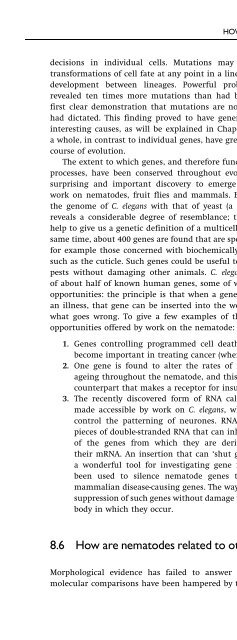An Introduction to the Invertebrates, Second Edition - tiera.ru
An Introduction to the Invertebrates, Second Edition - tiera.ru
An Introduction to the Invertebrates, Second Edition - tiera.ru
You also want an ePaper? Increase the reach of your titles
YUMPU automatically turns print PDFs into web optimized ePapers that Google loves.
HOW ARE NEMATODES RELATED TO OTHER ANIMALS?99decisions in individual cells. Mutations may result in discretetransformations of cell fate at any point in a lineage, or may switchdevelopment between lineages. Powerful probing of C. elegansrevealed ten times more mutations than had been predicted, <strong>the</strong>first clear demonstration that mutations are not as rare as <strong>the</strong>oryhad dictated. This finding proved <strong>to</strong> have general application andinteresting causes, as will be explained in Chapter 20. Genomes asa whole, in contrast <strong>to</strong> individual genes, have greatly changed in <strong>the</strong>course of evolution.The extent <strong>to</strong> which genes, and <strong>the</strong>refore fundamental biologicalprocesses, have been conserved throughout evolution is <strong>the</strong> mostsurprising and important discovery <strong>to</strong> emerge from comparativework on nema<strong>to</strong>des, f<strong>ru</strong>it flies and mammals. Even comparison of<strong>the</strong> genome of C. elegans with that of yeast (a unicellular fungus)reveals a considerable degree of resemblance; <strong>the</strong> differences mayhelp <strong>to</strong> give us a genetic definition of a multicellular animal. At <strong>the</strong>same time, about 400 genes are found that are specific <strong>to</strong> nema<strong>to</strong>des,for example those concerned with biochemically unique st<strong>ru</strong>cturessuch as <strong>the</strong> cuticle. Such genes could be useful <strong>to</strong> control nema<strong>to</strong>depests without damaging o<strong>the</strong>r animals. C. elegans has equivalentsof about half of known human genes, some of which offer medicalopportunities: <strong>the</strong> principle is that when a gene is known <strong>to</strong> causean illness, that gene can be inserted in<strong>to</strong> <strong>the</strong> worm <strong>to</strong> find exactlywhat goes wrong. To give a few examples of <strong>the</strong> potential use ofopportunities offered by work on <strong>the</strong> nema<strong>to</strong>de:1. Genes controlling programmed cell death in C. elegans maybecome important in treating cancer (where cells fail <strong>to</strong> die).2. One gene is found <strong>to</strong> alter <strong>the</strong> rates of metabolism and ofageing throughout <strong>the</strong> nema<strong>to</strong>de, and this gene has a humancounterpart that makes a recep<strong>to</strong>r for insulin.3. The recently discovered form of RNA called RNAi has beenmade accessible by work on C. elegans, where it is found <strong>to</strong>control <strong>the</strong> patterning of neurones. RNAi consists of smallpieces of double-stranded RNA that can inhibit <strong>the</strong> expressionof <strong>the</strong> genes from which <strong>the</strong>y are derived, by destroying<strong>the</strong>ir mRNA. <strong>An</strong> insertion that can ‘shut genes off ’ is clearlya wonderful <strong>to</strong>ol for investigating gene function: RNAi hasbeen used <strong>to</strong> silence nema<strong>to</strong>de genes that correspond <strong>to</strong>mammalian disease-causing genes. The way is open <strong>to</strong> medicalsuppression of such genes without damage <strong>to</strong> <strong>the</strong> living humanbody in which <strong>the</strong>y occur.8.6 How are nema<strong>to</strong>des related <strong>to</strong> o<strong>the</strong>r animals?Morphological evidence has failed <strong>to</strong> answer this question, andmolecular comparisons have been hampered by <strong>the</strong> unusually rapid











